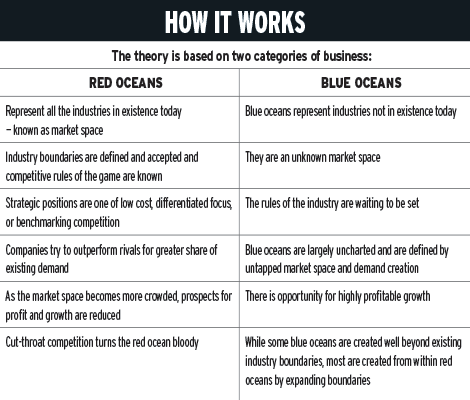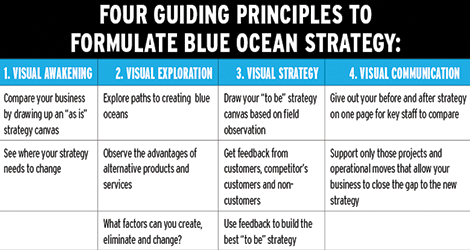The authors
W Chan Kim and Renée Mauborgne are the authors of Blue Ocean Strategy, first published in 2005. It’s a business management and organisational strategy book based on a Harvard Business Review article by the same authors.
The theory in a sentence
Blue ocean strategy illustrates how companies can break away from traditional models of competition (red ocean) by creating a new and uncontested market space (blue ocean) – making competition irrelevant.
But changing strategy involves risk. Why go there?
There is a rising need for creating blue oceans in business. Improved technology has increased industrial productivity and the array of products and services.
And, the trend toward globalisation means supply exceeds demand, information on products and prices are instantly available, price wars ensue and profit margins shrink. When products and services are forced by competition to become similar, consumers increasingly select based on price.
Need more incentive?
Look at this graph. The authors studied 108 companies and found 86% of their launches were line extensions – incremental improvements within a red ocean market space. But, these new launches only accounted for 62% of revenue impact and 38% of total profits. By contrast, 14% of the launches aimed at blue oceans generated 38% of total revenues and 61% of total profits
How to make your own blue ocean
Fundamentally, blue oceans use strategic logic called value innovation. Value without innovation focuses on incremental value creation – at the end of the day you won’t stand out in the market place. Innovation without value tends to be technology-driven, market pioneering or futuristic, shooting beyond what customers are ready to accept and pay for. Value innovation occurs only when companies align innovation with utility, price and cost position.
- CONVENTIONAL BELIEF: Companies can create greater value for customers through higher cost or reasonable value at lower cost.
- BLUE OCEAN FACT: Industries and companies pursue differentiation and low cost simultaneously.
Here’s an example
Cirque du Soleil started out in Canada in 1984. Since then it’s been seen by over 40 million people in 90 cities around the world. In 20 years it achieved a level of revenue that took circus industry giants Ringling Bros. and Barnum & Bailey more than 100 years to attain.
How is this possible in a declining industry? Cirque didn’t compete; instead it created an uncontested new market space of theatre meets circus that made the competition irrelevant. It appealed to a whole new group of customers: Adults and corporate clients prepared to pay a higher price for an unprecedented entertainment experience.
- Reconstruct market boundaries to create commercially compelling blue oceans.How? Blue ocean companies need to look across alternative industries, strategic groups, buyer groups, complementary product and service offerings, the functional-emotional orientation of an industry, and even across time.
- Focus on the big picture, not the numbers Most strategic planning is based on red oceans, driving companies to compete within existing market space. Drawing a strategy canvas visualises a company’s current strategic position and helps it chart its future strategy.
- Reach beyond existing demand Don’t fall into the trap of finer market segmentation, this risks creating too-small target markets. Instead, look to non-customers and build on commonalities in what buyers value. This allows companies to reach beyond existing demand to unlock a new mass of customers that didn’t exist before.
- Get the strategic sequence right By fleshing out and validating blue ocean ideas to determine their commercial viability, you dramatically reduce business model risk. Your company therefore needs to build strategy in the right sequence.










